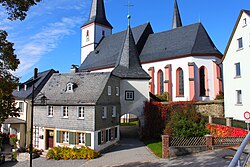Architectural history
The fortress church is typically surrounded by defensive walls equipped with wall towers and wall walks. It is a development of the fortified churches, whose defensive walls were also the actual walls of the church. Although the terms are often used interchangeably without clear distinction, a fortified church properly refers to a single building whereas a fortress church is a building complex. Construction of defensible churches evolved over time. Earlier constructions included a church surrounded by barns in which a siege of several days could be endured. Then fortified cemeteries (Wehrfriedhof) arose and simple fortified churches, to finally the fortress church. The fortress churches surviving today date from the 15th century.
Unlike the populations of towns and cities, villagers could not afford to build defences around an entire settlement. The fortress churches were often the only stone building in such places and so were the population's only refuge from the violence of the military conflicts, the local raiding and plundering that often accompanied military campaigns, as well as providing defence against nomadic bands of marauders.
In the Early Middle Ages, especially in recently Christianised regions like Saxony, former bishop's seats were designed as fortress churches. In Saxony they were referred to as a Domburg or "cathedral castle". Fortress churches are especially common in Franconia, South France and Transylvania (Romania). Particularly in Transylvania, a historically German settlement area, there are well over a hundred fortress churches of which seven have been designated as UNESCO World Heritage Sites (Birthälm/Biertan in 1993, Kelling/Calnic, Wurmloch/Valea Viilor, Dersch/Darjiu, Deutsch-Weißkirch/Viscri, Keisd/Saschiz and Tartlau/Prejmer in 1999). These were established in order to defend against successive Turkish invasions.
Fortress churches have not survived in North Germany, most likely due to the re-use of their stone for other building purposes during period of scarcity of such materials. The only well-known fortress church in the coastal region of North Germany is the Church of St. Dionysius in Bremerhaven-Wulsdorf, which is recorded as having a field stone curtain wall up to 3.60 metres high.
This page is based on this
Wikipedia article Text is available under the
CC BY-SA 4.0 license; additional terms may apply.
Images, videos and audio are available under their respective licenses.












